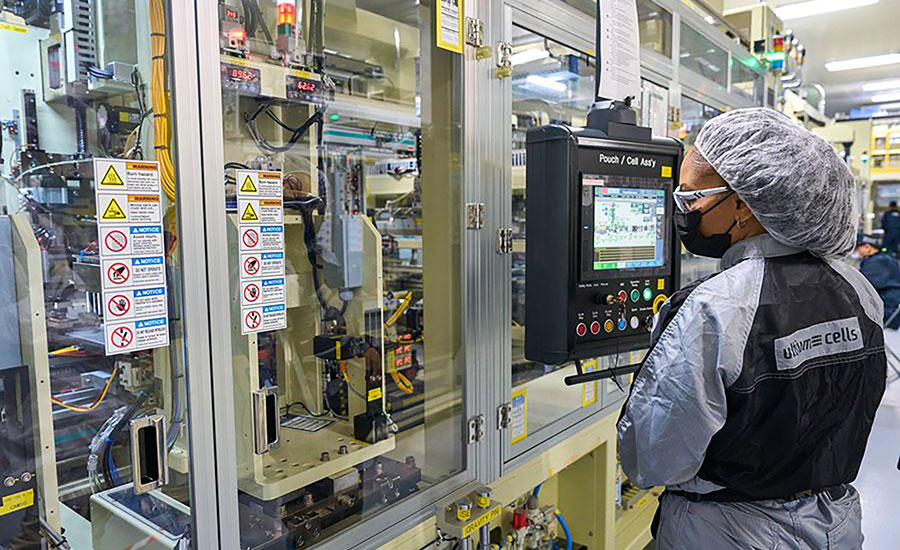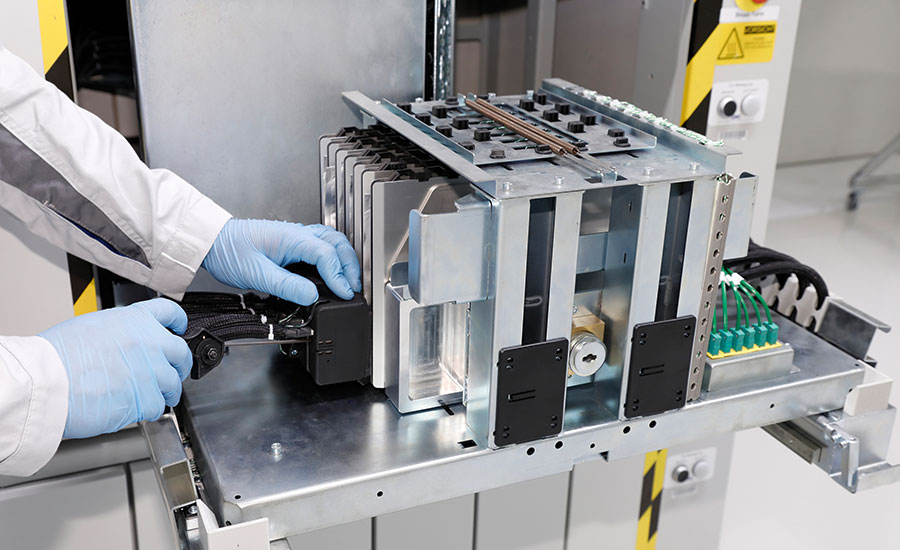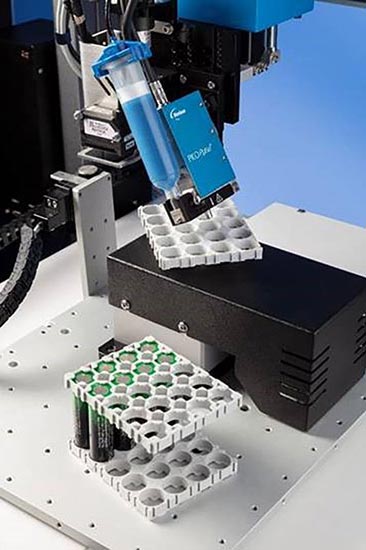Global demand for lithium-ion batteries is soaring. To meet short- and long-term goals, manufacturers must find ways to improve their battery cell, module and pack assembly operations. They need to invest in efficient production processes that reduce cost, improve quality and boost throughput.
Fluid dispensing plays a key role in improving the mechanical strength, thermal conductivity and chemical inertness of batteries. Tiny amounts of adhesives, silicones, electrolytes and thermal interface materials must be dispensed reliably and accurately in dosage and placement. The precise positioning and quantity of these fluids is critical to a battery’s function, quality, safety, appearance and viability.
Engineers must carefully assess how to dispense fluids onto hard-to-access areas, uneven or irregularly shaped surfaces, or delicate substrates. Numerous variable can affect the Z-axis movement of the dispensing system, influencing its ability to move over uneven surfaces and dispense the correct volume of fluids in the right locations.
An efficient, controlled dispensing method provides numerous benefits, such as:
- Shot-to-shot repeatability and accuracy are considerably improved when an automated and controlled dispensing approach is employed.
- Increased automation results in improved productivity.
- Part quality improves when switching to in-line automated dispensing, because operator-to-operator variance is significantly reduced. The ability to set precise dispensing parameters for an application improves process control and ensures that the right amount of fluid is placed on each part.
- Rework and reject rates are reduced.
- The amount of fluid used decreases significantly.
State-of-the-art automated dispensing equipment provides a high degree of process control. With the ability to dispense dots, beads and fills under a broad range of conditions, these units are equipped with multiple capabilities.
Engineers can choose a variety of tools, including benchtop fluid dispensers, pneumatic valve systems, progressive cavity pumps, piezoelectric jetting valve systems and in-line automated dispensing systems.

Electric vehicle battery manufacturers need efficient production processes that reduce cost, improve quality and boost throughput. Photo courtesy Ultium Cells
Repeatability, Accuracy and Process Control
Whether applying UV-cure adhesives to a battery module assembly or dispensing adhesive to adhere anode and cathode layers, it’s important to determine the best dispensing parameters.
Shot-to-shot repeatability and accuracy are critical factors. Depositing the right amount of fluid has a compounding consequence of not only maintaining product integrity, but also keeping downstream production moving. The latest generation of fluid dispensers can dispense practically all assembly fluids with precision.
When coupled with cameras and confocal lasers, vision-guided automation platforms, such as automated optical inspection (AOI) systems, ensure fluid deposit volume and placement accuracy.
AOI software verifies fluid deposit widths and diameters. Robotic systems measure the height of a fluid deposit in addition to the width and diameter, providing 3D verification. Confocal lasers measure the heights of deposits regardless of the transparency of the fluid, which can sometimes distort quality data. Constant closed-loop feedback delivers automated quality control data.
Battery cell and module dispensing applications for EVs require various low- to medium-viscosity adhesives to glue components together. To assemble the battery management electronics for EV battery packs, precision valves are required to dispense extremely small amounts of UV-cure adhesives.

Jet valves provide a noncontact fluid dispensing method that is fast and accurate. Photo courtesy Nordson EFD
Jet valves, dispense valves and automated dispensing systems help manufacturers produce defect-free batteries at faster production speeds by applying precise amounts of fluids within tight deposit size and positional tolerances.
Adhering anode, separator and cathode layers requires small, precise amounts of material to attach more than 100 thin electrode layers contained in cylindrical and prismatic lithium-ion batteries. Each application requires a fast dispense time between 1 and 4 seconds per dot of adhesive applied between the layers of each battery cell.
For this application, jetting systems provide the most control at the high speeds. They dispense fluid deposits as small as 0.5 nanoliters at up to 1,000 hertz (Hz) with bursts up to 1,500 Hz continuously.
Products such as Nordson EFD’s recently released PICO Pµlse XP piezo jetting system are designed to maintain precise, repeatable noncontact fluid dispensing regardless of external factors such as temperature changes. Its sustained stroke target permits the valve to self-adjust to maintain a micron-level stroke setting for long periods, despite changes in environmental conditions that can alter dispense results over time.
Dispensing equipment must also be able to withstand the corrosive properties associated with filling electrolyte cells. Accurate, repeatable amounts of adhesive are required to seal the top of cylindrical and prismatic battery cells to prevent short-cuts. Jetting dispense systems provide the speed and accuracy needed to keep up with the throughput and quality assurance requirements of this application.

Battery manufacturers are eager to automate manual assembly processes. Photo courtesy Volkswagen AG
Thermal Management
Thermal runaway can threaten the safety and performance of battery packs. Thermal interface materials (TIMs) help prevent this by absorbing heat from overheated batteries. TIMs are dispensed to draw heat away from sensitive components, and toward outer casings or heat sinks.
To achieve this, engineers need to calculate and precisely apply the right amount of TIM at the exact locations in battery modules and battery pack.
When applying TIMs, the conventional approach has been to apply thermal tape or thermal gap pads manually instead of thermal grease because of cost reductions. But, the pads do not always conform to different gap geometries, which does not allow consistent coverage of thermal material on the part.
For some applications, battery manufacturers use a handheld fluid dispenser to apply fluid manually, which allows coverage that thermal tape and gap pads do not always provide. However, with manual dispensing, coverage inconsistencies frequently occur due to operator-to-operator variability.
One alternative is to use progressive cavity pumps, which are designed for applying thermal paste into battery heat sinks. Pumps provide a perfectly sealed metering chamber that prevents shear, pulsation and squeezing of the fluid that can sometimes crush delicate fillers and particles used in thermal pastes.
Potting and sealing electrical components helps prevent moisture or other foreign matter from entering the battery case and causing malfunctions. For potting applications, progressive cavity pumps provide repeatable volumetric filling of small cavities.
Conformal Coating and Sealing
Coating densely populated circuit boards for EV batteries is critical for waterproofing and preventing corrosion and oxidation. This requires precise deposition of conformal coating fluid, into narrow, hard-to-reach areas without over-deposits and migrating of the coating, which could lead to contamination of other parts of the board and potential product failure.

Using modular jet valve technology, manufacturers can apply precise, repeatable micro-deposits to bond cylindrical cells to battery modules. Photo courtesy Nordson EFD
Battery manufacturers typically use a film coater to selectively apply conformal coatings. To facilitate application with this system, the coating is frequently diluted with a solvent to improve its flow characteristics.
Thinning can lead to over-deposits in areas where coating should not go, potentially reducing the integrity of the coating to effectively protect the board and adding production steps to manage the over-deposits. Replacing the film coater with a jetting valve allows manufacturers to apply the exact amount of conformal coating needed without diluting the fluid first.
Case bonding and gasketing completes the full battery assembly, adding final structural rigidity and protection. Typically, epoxy or silicone materials are used. These adhesives offer fast curing times and make battery packs both waterproof and serviceable.
Robotic dispensing has evolved to support the high throughput needs of battery manufacturers. Many applications involve attaching a valve to a six-axis robot arm, or using the valve with a three-axis tabletop robot. A conveyor can often be used in conjunction with robotic dispensing system to further increase output.
The robot’s 3D motion control allows programming of dots, lines, circles, arcs and compound arcs.






